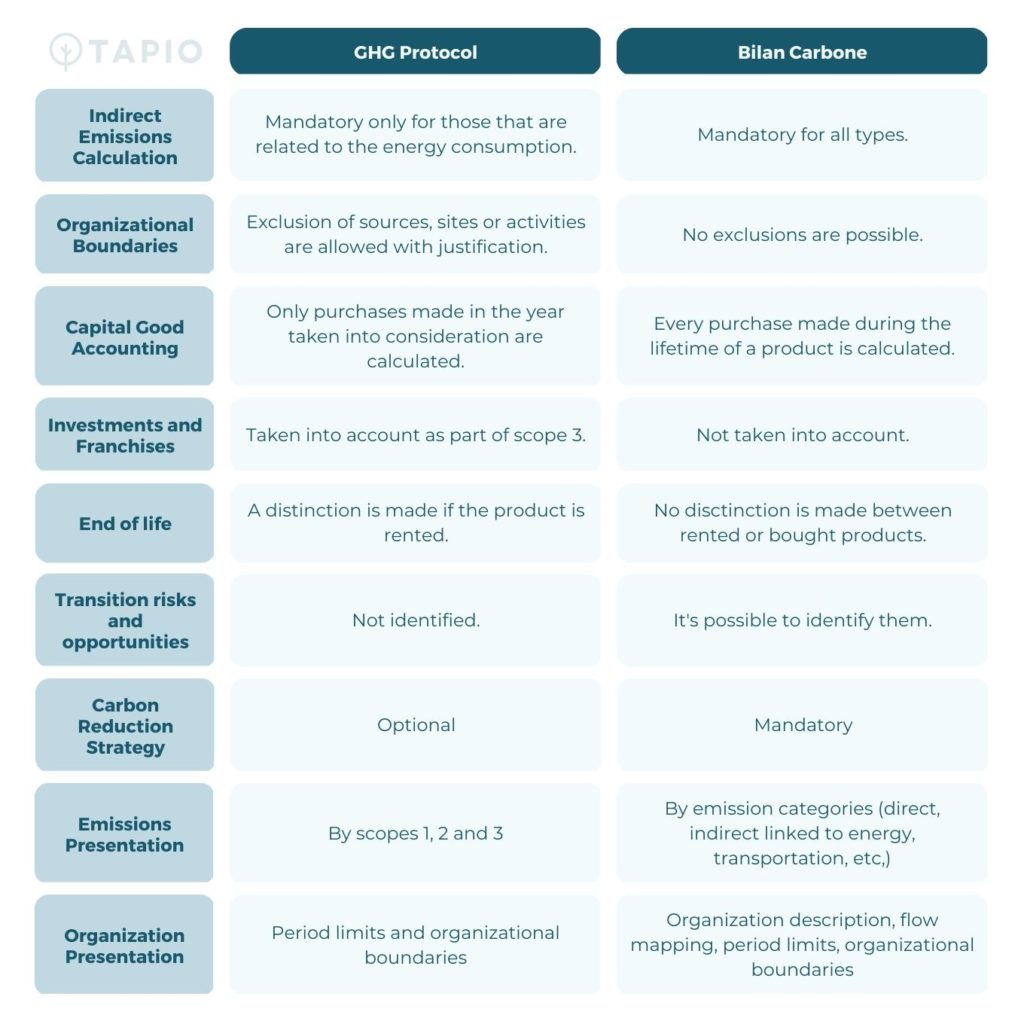
Carbon reports and low carbon strategies are becoming more and more widespread within organizations. If you’re considering calculating the carbon emissions of your company, you might be wondering which international standard you should follow for your carbon report. In this article, we’ll explore the difference between the GHG Protocol and the Bilan Carbone, two of the most widely used standards, and we’ll help you decide which methodology suits your company best.
What is the Bilan Carbone® method?
The Bilan Carbone® method was created in 2004 by ADEME, the French Environment and Energy Management Agency, to quantify the greenhouse gasses of individuals and organizations. The Bilan Carbone® method takes into account all the greenhouse gasses mentioned in the reports of the Intergovernmental Panel on Climate Change and is compatible with other standards such as the ISO 14064.
ADEME’s Bilan Carbone method accounts for both direct and indirect emissions, which are divided in various emission categories, such as transportation, energy consumption, purchase of goods and services, etc. Read our full guide on the Bilan Carbone methodology to dicsover more.
What is the GHG Protocol?
The GHG Protocol was created in 1998 to establish an international standard to calculate the emissions of an organization’s value chain. Its aim is to simplify and reduce the costs of carbon reporting. This is the most widely used method internationally. Thanks to it, it’s become easier to compare the carbon footprint of different national and international entities.
The GHG Protocol, just like the Bilan Carbone, takes into account both direct and indirect emissions and divides them in emission scopes 1, 2, and 3.
Differences between the GHG Protocol and the Bilan Carbone
As we’ve seen, both the GHG Protocol and the Bilan Carbone are internationally recognized standards that account for both direct and indirect emissions. However, there are some differences regarding how they classify emissions, set organizational boundaries, and more.
- They calculate indirect emissions differently
In the Bilan Carbone, all indirect emissions have to be taken into account, while for the GHG Protocol, only indirect emissions associated with energy consumption have to be calculated. Other emission categories, such as those linked with transportation, services and goods, are optional.
- They set different organizational boundaries
The first step to a carbon report is to understand and determine the boundaries of your organization. With the GHG Protocol, you are allowed to exclude some sites of activities if you provide a justification, whereas the Bilan Carbone doesn’t allow such exclusion.
- They account for capital goods differently
A carbon report made with the GHG Protocol will account only for capital goods purchased during the year the report refers to. The Bilan Carbone method includes the inventory of every asset and amortization over the lifetime of a product.
- They have different requirements for action plans
If you choose the Bilan Carbone methodology, you’ll also commit to creating a mandatory action plan for your company aiming at reducing its carbon footprint. This is only optional for companies following the GHG Protocol.
- They present results differently
As mentioned before, the Bilan Carbone presents results by emission categories, namely direct emissions and indirect emissions related to the purchase and sale of services and goods, transportation, energy consumption, and other. The GHG Protocol divides results in emission scopes 1, 2, and 3. The first scope concerns direct emissions, and the second and third include different types of indirect emissions.
In the table below, you’ll find the complete list of the differences between the GHG Protocol and the Bilan Carbone.

Which carbon footprint standard do I need for my carbon report?
In practice, Bilan Carbone and the GHG Protocol are very similar. Your organization will have to use a specific carbon reporting standard and methodology based on the needs, the goals and the country where it is located.
French institutions, for example, require that companies that are obliged to report on their emissions use the Bilan Carbone method, while the GHG Protocol is used internationally.
Organizations that aren’t required by law to compile a carbon report, can choose the standard that fits best their goals and needs. At Tapio, we have created a comprehensive and customisable platform that can be adapted to all two reference systems!
Regardless of the methodology chosen, our experts go the extra mile to improve the accuracy of the results and make carbon reports as complete and transparent as possible. Tapio’s ambition is to help companies understand their emissions and seamlessly implement a carbon reduction strategy, by visualising the emission categories in auditable and easy-to-understand reports – no matter the chosen emissions calculation method.
Read our full guide on corporate carbon reports to discover more.
Need a carbon report?